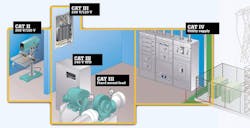Maintenance professionals are constantly being deluged with new models, new manufacturers, and new functionality in handheld digital multimeters. Safety features are perhaps the most critical factors in that decision, but it is sometimes difficult to sift through all the specifications to determine which represent the best tool for your application. To help put it all in perspective, here are some of the key points to consider when selecting a digital multimeter.
What is your true voltage environment?
A common misconception is that as long as you choose a multimeter with a high enough voltage rating, you’re covered. However, the voltage rating is only part of the story.
A multimeter may be subjected to much higher voltage than the user thought was being measured due to a momentary high-voltage spike or transient surge that hits the multimeter input without warning. Your safety depends on the safety margin built into your meter — and that is based on several specifications beyond the voltage rating.
What CAT rating is required for your environment?
The International Electrotechnical Commission (IEC) publishes standards for all electrical, electronic, and related technologies. The most important thing to understand about the IEC safety standards is the “measurement category.” Make sure that any meter you consider has an IEC Category (CAT) rating that is appropriate for the electrical environment in which you will use it.
The CAT rating typically appears near the multimeter input jacks. Multimeters that are not CAT rated should never be used in high energy, 3-phase electrical work environments. Be sure that the test leads you use with the meter have an equal or greater CAT rating as well. The categories related to commercial and industrial work are noted in Table 1.
It is important to consider both the CAT rating and the voltage rating. For example, a CAT III 1,000V meter offers superior protection to a CAT III 600V rated meter, but a CAT II 1,000V rated meter is not superior to a CAT III 600V rated meter. That is because in calculating the voltage-withstand ratings, IEC 61010-1 test procedures take into account steady-state voltage, peak impulse transient voltage, and source impedance. Table 2 shows those values in context with the various CAT ratings.
What IP rating do you need?
If you work outdoors in harsh, wet, and or dusty environments, you’ll need a water- and dust-resistant multimeter. Water and dust resistance standards are defined in IEC 60529 as levels of “ingress protection” (IP) from solids and water.
An IP rating has two digits. The first specifies the size of excluded objects. “Zero” indicates no protection, and “6” means that it is dustproof. The second digit specifies the level of protection against water. “Zero” indicates no protection, and “8” means that it is protected against continuous immersion in one meter of water. For example, a rating of “IP67” means the meter is tested to be dustproof and to withstand immersion in water to a depth of one meter for 30 min.
Note: Safety certification testing for IEC 61010 does not test for compliance with the IEC 60529 IP standard, so check with the manufacturer or vendor for proof of compliance.
How rugged does your meter need to be?
As careful as technicians may be, multimeters still are subjected to rough use on a daily basis. So look for a solid, well-built instrument that is free of obvious defects and is built to withstand years of tough use. The most common measure of ruggedness is the IEC 61010 safety standard, which specifies that a product must survive a one-meter drop at both its highest and lowest specified operating temperatures. If you’ve ever seen what happens to a meter that doesn’t meet that requirement after a one-meter drop on a concrete floor, you know how important that specification is.
Is the meter independently tested?
Independent certification is a key attribute of a quality meter. To be sure that the multimeter you’re using is rated for safety, look for at least one (more is better) of the certifications shown in Fig. 1. The marks will be stamped on the meter body and included in the product’s brochures and catalogs. The presence of those marks ensures the meter has been independently tested and certified to meet those agencies’ certification requirements. If in doubt, ask the vendor or manufacturer for proof of compliance with established safety standards.
A final note. If you are looking to replace your multimeter, start by analyzing the worse-case scenario for your job, and choose the measurement category for that scenario (Fig. 2). Then choose a meter rated for that measurement category with the highest voltage rating you will need within that category.
Silvey is an application specialist with Fluke Corp. in Everett, Wash. (www.fluke.com).








